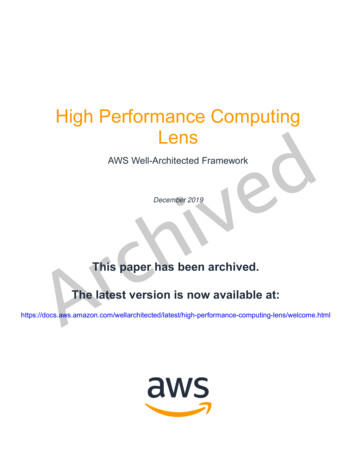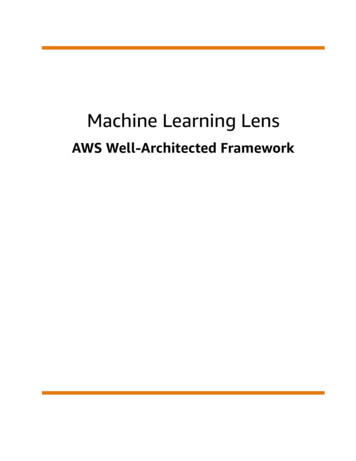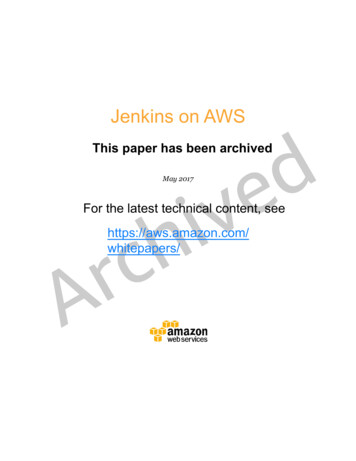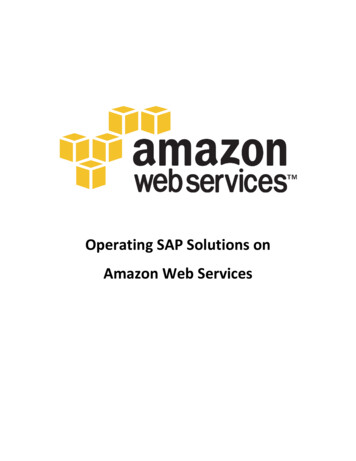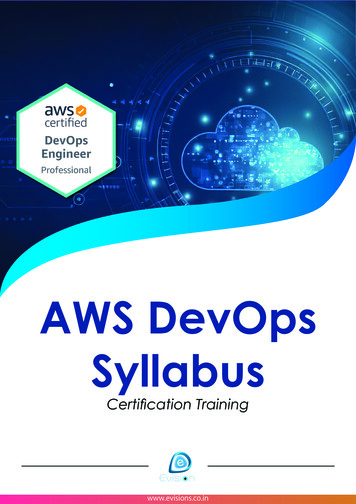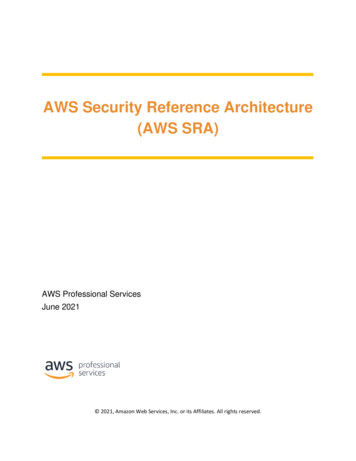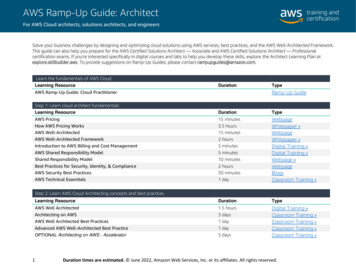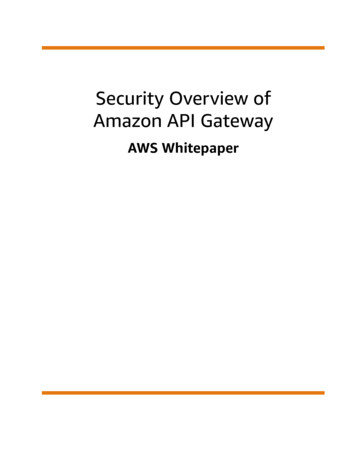
Transcription
Reliability PillardeAWS Well-Architected FrameworkvihThis paper has been archived.crAThe latest version is now available est/reliability-pillar/welcome.html
Reliability Pillar AWS Well-Architected FrameworkReliability Pillar: AWS Well-Architected FrameworkCopyright 2020 Amazon Web Services, Inc. and/or its affiliates. All rights reserved.Amazon's trademarks and trade dress may not be used in connection with any product or service that is notAmazon's, in any manner that is likely to cause confusion among customers, or in any manner that disparages ordiscredits Amazon. All other trademarks not owned by Amazon are the property of their respective owners, who mayor may not be affiliated with, connected to, or sponsored by Amazon.crAvihde
Reliability Pillar AWS Well-Architected FrameworkTable of ContentsAbstract . 1Abstract . 1Introduction . 2Reliability . 3Design Principles . 3Definitions . 3Resiliency, and the Components of Reliability . 4Availability . 4Disaster Recovery (DR) Objectives . 7Understanding Availability Needs . 8Foundations . 9Manage Service Quotas and Constraints . 9Resources . 10Plan your Network Topology . 10Resources . 14Workload Architecture . 15Design Your Workload Service Architecture . 15Resources . 17Design Interactions in a Distributed System to Prevent Failures . 17Resources . 19Design Interactions in a Distributed System to Mitigate or Withstand Failures . 20Resources . 24Change Management . 25Monitor Workload Resources . 25Resources . 28Design your Workload to Adapt to Changes in Demand . 28Resources . 29Implement Change . 30Additional deployment patterns to minimize risk: . 32Resources . 32Failure Management . 34Back up Data . 34Resources . 35Use Fault Isolation to Protect Your Workload . 36Resources . 40Design your Workload to Withstand Component Failures . 41Resources . 43Test Reliability . 44Resources . 46Plan for Disaster Recovery (DR) . 47Resources . 49Example Implementations for Availability Goals . 50Dependency Selection . 50Single-Region Scenarios . 502 9s (99%) Scenario . 513 9s (99.9%) Scenario . 524 9s (99.99%) Scenario . 54Multi-Region Scenarios . 563½ 9s (99.95%) with a Recovery Time between 5 and 30 Minutes . 565 9s (99.999%) or Higher Scenario with a Recovery Time under 1 minute . 59Resources . 61Documentation . 61Labs . 62External Links . 62devihcrAiii
Reliability Pillar AWS Well-Architected FrameworkBooks .Conclusion .Contributors .Further Reading .Document Revisions .Appendix A: Designed-For Availability for Select AWS Services .626364656668devihcrAiv
Reliability Pillar AWS Well-Architected FrameworkAbstractReliability Pillar - AWS WellArchitected FrameworkPublication date: July 2020 (Document Revisions (p. 66))AbstractdeThe focus of this paper is the reliability pillar of the AWS Well-Architected Framework. It providesguidance to help customers apply best practices in the design, delivery, and maintenance of AmazonWeb Services (AWS) environments.vihcrA1
Reliability Pillar AWS Well-Architected FrameworkIntroductionThe AWS Well-Architected Framework helps you understand the pros and cons of decisions you makewhile building workloads on AWS. By using the Framework you will learn architectural best practicesfor designing and operating reliable, secure, efficient, and cost-effective workloads in the cloud. Itprovides a way to consistently measure your architectures against best practices and identify areas forimprovement. We believe that having well-architected workload greatly increases the likelihood ofbusiness success.deThe AWS Well-Architected Framework is based on five pillars: Operational ExcellenceSecurityReliabilityPerformance EfficiencyCost OptimizationvihThis paper focuses on the reliability pillar and how to apply it to your solutions. Achieving reliabilitycan be challenging in traditional on-premises environments due to single points of failure, lack ofautomation, and lack of elasticity. By adopting the practices in this paper you will build architecturesthat have strong foundations, resilient architecture, consistent change management, and proven failurerecovery processes.crAThis paper is intended for those in technology roles, such as chief technology officers (CTOs), architects,developers, and operations team members. After reading this paper, you will understand AWS bestpractices and strategies to use when designing cloud architectures for reliability. This paper includeshigh-level implementation details and architectural patterns, as well as references to additionalresources.2
Reliability Pillar AWS Well-Architected FrameworkDesign PrinciplesReliabilityThe reliability pillar encompasses the ability of a workload to perform its intended function correctly andconsistently when it’s expected to. This includes the ability to operate and test the workload through itstotal lifecycle. This paper provides in-depth, best practice guidance for implementing reliable workloadson AWS.Topics Design Principles (p. 3)de Definitions (p. 3) Understanding Availability Needs (p. 8)Design PrinciplesvihIn the cloud, there are a number of principles that can help you increase reliability. Keep these in mind aswe discuss best practices: Automatically recover from failure: By monitoring a workload for key performance indicators(KPIs), you can trigger automation when a threshold is breached. These KPIs should be a measure ofbusiness value, not of the technical aspects of the operation of the service. This allows for automaticnotification and tracking of failures, and for automated recovery processes that work around or repairthe failure. With more sophisticated automation, it’s possible to anticipate and remediate failuresbefore they occur.crA Test recovery procedures: In an on-premises environment, testing is often conducted to provethat the workload works in a particular scenario. Testing is not typically used to validate recoverystrategies. In the cloud, you can test how your workload fails, and you can validate your recoveryprocedures. You can use automation to simulate different failures or to recreate scenarios that led tofailures before. This approach exposes failure pathways that you can test and fix before a real failurescenario occurs, thus reducing risk. Scale horizontally to increase aggregate workload availability: Replace one large resource withmultiple small resources to reduce the impact of a single failure on the overall workload. Distributerequests across multiple, smaller resources to ensure that they don’t share a common point of failure. Stop guessing capacity: A common cause of failure in on-premises workloads is resource saturation,when the demands placed on a workload exceed the capacity of that workload (this is often theobjective of denial of service attacks). In the cloud, you can monitor demand and workload utilization,and automate the addition or removal of resources to maintain the optimal level to satisfy demandwithout over- or under-provisioning. There are still limits, but some quotas can be controlled andothers can be managed (see Manage Service Quotas and Constraints (p. 9)). Manage change in automation: Changes to your infrastructure should be made using automation. Thechanges that need to be managed include changes to the automation, which then can be tracked andreviewed.DefinitionsThis whitepaper covers reliability in the cloud, describing best practice for these four areas: Foundations Workload Architecture3
Reliability Pillar AWS Well-Architected FrameworkResiliency, and the Components of Reliability Change Management Failure ManagementTo achieve reliability you must start with the foundations—an environment where service quotas andnetwork topology accommodate the workload. The workload architecture of the distributed systemmust be designed to prevent and mitigate failures. The workload must handle changes in demand orrequirements, and it must be designed to detect failure and automatically heal itself.Topics Resiliency, and the components of Reliability (p. 4) Availability (p. 4) Disaster Recovery (DR) Objectives (p. 7)deResiliency, and the components of ReliabilityReliability of a workload in the cloud depends on several factors, the primary of which is Resiliency:vih Resiliency is the ability of a workload to recover from infrastructure or service disruptions, dynamicallyacquire computing resources to meet demand, and mitigate disruptions, such as misconfigurations ortransient network issues.The other factors impacting workload reliability are: Operational Excellence, which includes automation of changes, use of playbooks to respond to failures,and Operational Readiness Reviews (ORRs) to confirm that applications are ready for productionoperations. Security, which includes preventing harm to data or infrastructure from malicious actors, which wouldimpact availability. For example, encrypt backups to ensure that data is secure. Performance Efficiency, which includes designing for maximum request rates and minimizing latenciesfor your workload. Cost Optimization, which includes trade-offs such as whether to spend more on EC2 instances toachieve static stability, or to rely on automatic scaling when more capacity is needed.crAResiliency is the primary focus of this whitepaper.The other four aspects are also important and they are covered by their respective pillars of the AWSWell-Architected Framework. Many of the best practices here also address those aspects of reliability, butthe focus is on resiliency.AvailabilityAvailability (also known as service availability) is both a commonly used metric to quantitatively measureresiliency, as well as a target resiliency objective. Availability is the percentage of time that a workload is available for use.Available for use means that it performs its agreed function successfully when required.This percentage is calculated over a period of time, such as a month, year, or trailing three years.Applying the strictest possible interpretation, availability is reduced anytime that the application isn’toperating normally, including both scheduled and unscheduled interruptions. We define availability asfollows:4
Reliability Pillar AWS Well-Architected FrameworkAvailability Availability is a percentage uptime (such as 99.9%) over a period of time (commonly a month or year) Common short-hand refers only to the “number of nines”; for example, “five nines” translates to being99.999% available Some customers choose to exclude scheduled service downtime (for example, planned maintenance)from the Total Time in the formula. However, this is not advised, as your users will likely want to useyour service during these times.deHere is a table of common application availability design goals and the maximum length of time thatinterruptions can occur within a year while still meeting the goal. The table contains examples of thetypes of applications we commonly see at each availability tier. Throughout this document, we refer tothese values.vihAvailabilityMaximum Unavailability (peryear)Application Categories99% (p. 51)3 days 15 hoursBatch processing, dataextraction, transfer, and loadjobs99.9% (p. 52)8 hours 45 minutesInternal tools like knowledgemanagement, project tracking99.95% (p. 56)4 hours 22 minutesOnline commerce, point of sale99.99% (p. 54)52 minutesVideo delivery, broadcastworkloads99.999% (p. 59)5 minutesATM transactions,telecommunications workloadscrAMeasuring availability based on requests. For your service it may be easier to count successful andfailed requests instead of “time available for use”. In this case the following calculation can be used:This is often measured for one-minute or five-minute periods. Then a monthly uptime percentage (timebase availability measurement) can be calculated from the average of these periods. If no requests arereceived in a given period it is counted at 100% available for that time.Calculating availability with hard dependencies. Many systems have hard dependencies on othersystems, where an interruption in a dependent system directly translates to an interruption of the5
Reliability Pillar AWS Well-Architected FrameworkAvailabilityinvoking system. This is opposed to a soft dependency, where a failure of the dependent systemis compensated for in the application. Where such hard dependencies occur, the invoking system’savailability is the product of the dependent systems’ availabilities. For example, if you have a systemdesigned for 99.99% availability that has a hard dependency on two other independent systems thateach are designed for 99.99% availability, the workload can theoretically achieve 99.97% availability:Availinvok Availdep1 Availdep2 Availworkload99.99% 99.99% 99.99% 99.97%It’s therefore important to understand your dependencies and their availability design goals as youcalculate your own.deCalculating availability with redundant components. When a system involves the use of independent,redundant components (for example, redundant resources in different Availability Zones), the theoreticalavailability is computed as 100% minus the product of the component failure rates. For example, if asystem makes use of two independent components, each with an availability of 99.9%, the effectiveavailability of this dependency is 99.9999%:vihcrAAvaileffective AvailMAX ((100% Availdependency) (100% Availdependency))99.9999% 100% (0.1% 0.1%)Shortcut calculation: If the availabilities of all components in your calculation consist solely of the digitnine, then you can sum the count of the number of nines digits to get your answer. In the above exampletwo redundant, independent components with three nines availability results in six nines.Calculating dependency availability. Some dependencies provide guidance on their availability,including availability design goals for many AWS services (see Appendix A: Designed-For Availability forSelect AWS Services (p. 68)). But in cases where this isn’t available (for example, a component wherethe manufacturer does not publish availability information), one way to estimate is to determine theMean Time Between Failure (MTBF) and Mean Time to Recover (MTTR). An availability estimate can beestablished by:For example, if the MTBF is 150 days and the MTTR is 1 hour, the availability estimate is 99.97%.6
Reliability Pillar AWS Well-Architected FrameworkDisaster Recovery (DR) ObjectivesFor additional details, see this document (Calculating Total System Availability), which can help youcalculate your availability.Costs for availability. Designing applications for higher levels of availability typically results inincreased cost, so it’s appropriate to identify the true availability needs before embarking on yourapplication design. High levels of availability impose stricter requirements for testing and validationunder exhaustive failure scenarios. They require automation for recovery from all manner of failures,and require that all aspects of system operations be similarly built and tested to the same standards.For example, the addition or removal of capacity, the deployment or rollback of updated software orconfiguration changes, or the migration of system data must be conducted to the desired availabilitygoal. Compounding the costs for software development, at very high levels of availability, innovationsuffers because of the need to move more slowly in deploying systems. The guidance, therefore, is tobe thorough in applying the standards and considering the appropriate availability target for the entirelifecycle of operating the system.deAnother way that costs escalate in systems that operate with higher availability design goals is in theselection of dependencies. At these higher goals, the set of software or services that can be chosen asdependencies diminishes based on which of these services have had the deep investments we previouslydescribed. As the availability design goal increases, it’s typical to find fewer multi-purpose services(such as a relational database) and more purpose-built services. This is because the latter are easier toevaluate, test, and automate, and have a reduced potential for surprise interactions with included butunused functionality.vihDisaster Recovery (DR) ObjectivesIn addition to availability objectives, your resiliency strategy should also include Disaster Recovery (DR)objectives based on strategies to recover your workload in case of a disaster event. Disaster Recoveryfocuses on one-time recovery objectives in response natural disasters, large-scale technical failures, orhuman threats such as attack or error. This is different than availability which measures mean resiliencyover a period of time in response to component failures, load spikes, or software bugs.crARecovery Time Objective (RTO) Defined by the organization. RTO is the maximum acceptable delaybetween the interruption of service and restoration of service. This determines what is considered anacceptable time window when service is unavailable.Recovery Point Objective (RPO) Defined by the organization. RPO is the maximum acceptable amountof time since the last data recovery point. This determines what is considered an acceptable loss of databetween the last recovery point and the interruption of service.7
Reliability Pillar AWS Well-Architected FrameworkUnderstanding Availability NeedsThe relationship of RPO (Recovery Point Objective), RTO (Recovery Time Objective), and the disaster event.RTO is similar to MTTR (Mean Time to Recovery) in that both measure the time between the start of anoutage and workload recovery. However MTTR is a mean value taken over several availability impactingevents over a period of time, while RTO is a target, or maximum value allowed, for a single availabilityimpacting event.Understanding Availability NeedsIt’s common to initially think of an application’s availability as a single target for the application asa whole. However, upon closer inspection, we frequently find that certain aspects of an applicationor service have different availability requirements. For example, some systems might prioritize theability to receive and store new data ahead of retrieving existing data. Other systems prioritize realtime operations over operations that change a system’s configuration or environment. Services mighthave very high availability requirements during certain hours of the day, but can tolerate much longerperiods of disruption outside of these hours. These are a few of the ways that you can decompose asingle application into constituent parts, and evaluate the availability requirements for each. The benefitof doing this is to focus your efforts (and expense) on availability according to specific needs, rather thanengineering the whole system to the strictest requirement.devihRecommendationCritically evaluate the unique aspects to your applications and, where appropriate, differentiate theavailability and disaster recovery design goals to reflect the needs of your business.crAWithin AWS, we commonly divide services into the “data plane” and the “control plane.” The data planeis responsible for delivering real-time service while control planes are used to configure the environment.For example, Amazon EC2 instances, Amazon RDS databases, and Amazon DynamoDB table read/writeoperations are all data plane operations. In contrast, launching new EC2 instances or RDS databases,or adding or changing table metadata in DynamoDB are all considered control plane operations. Whilehigh levels of availability are important for all of these capabilities, the data planes typically have higheravailability design goals than the control planes. Therefore workloads with high availability requirementsshould avoid run-time dependency on control plan operations.Many AWS customers take a similar approach to critically evaluating their applications and identifyingsubcomponents with different availability needs. Availability design goals are then tailored to thedifferent aspects, and the appropriate work efforts are executed to engineer the system. AWS hassignificant experience engineering applications with a range of availability design goals, includingservices with 99.999% or greater availability. AWS Solution Architects (SAs) can help you designappropriately for your availability goals. Involving AWS early in your design process improves our abilityto help you meet your availability goals. Planning for availability is not only done before your workloadlaunches. It’s also done continuously to refine your design as you gain operational experience, learn fromreal world events, and endure failures of different types. You can then apply the appropriate work effortto improve upon your implementation.The availability needs that are required for a workload must be aligned to the business need andcriticality. By first defining business criticality framework with defined RTO, RPO, and availability, you canthen assess each workload. Such an approach requires that the people involved in implementation of theworkload are knowledgeable of the framework, and the impact their workload has on business needs.8
Reliability Pillar AWS Well-Architected FrameworkManage Service Quotas and ConstraintsFoundationsFoundational requirements are those whose scope extends beyond a single workload or project. Beforearchitecting any system, foundational requirements that influence reliability should be in place. Forexample, you must have sufficient network bandwidth to your data center.In an on-premises environment, these requirements can cause long lead times due to dependencies andtherefore must be incorporated during initial planning. With AWS however, most of these foundationalrequirements are already incorporated or can be addressed as needed. The cloud is designed to benearly limitless, so it’s the responsibility of AWS to satisfy the requirement for sufficient networking andcompute capacity, leaving you free to change resource size and allocations on demand.deThe following sections explain best practices that focus on these considerations for reliability.vihTopics Manage Service Quotas and Constraints (p. 9) Plan your Network Topology (p. 10)Manage Service Quotas and ConstraintscrAFor cloud-based workload architectures, there are service quotas (which are also referred to as servicelimits). These quotas exist to prevent accidentally provisioning more resources than you need and to limitrequest rates on API operations so as to protect services from abuse. There are also resource constraints,for example, the rate that you can push bits down a fiber-optic cable, or the amount of storage on aphysical disk.If you are using AWS Marketplace applications, you must understand the limitations of thoseapplications. If you are using third-party web services or software as a service, you must be aware ofthose limits also.Aware of service quotas and constraints: You are aware of your default quotas and quota increaserequests for your workload architecture. You additionally know which resource constraints, such as diskor network, are potentially impactful.Service Quotas is an AWS service that helps you manage your quotas for over 100 AWS services fromone location. Along with looking up the quota values, you can also request and track quota increasesfrom the Service Quotas console or via the AWS SDK. AWS Trusted Advisor offers a service quotas checkthat displays your usage and quotas for some aspects of some services. The default service quotas perservice are also in the AWS documentation per respective service, for example, see Amazon VPC Quotas.Rate limits on throttled APIs are set within the
Reliability Pillar - AWS Well-Architected Framework Publication date: July 2020 (Document Revisions (p. 66)) Abstract The focus of this paper is the reliability pillar of the AWS Well-Architected Framework. It provides guidance to help customers apply best practices in the design, delivery, and maintenance of Amazon Web Services (AWS .

